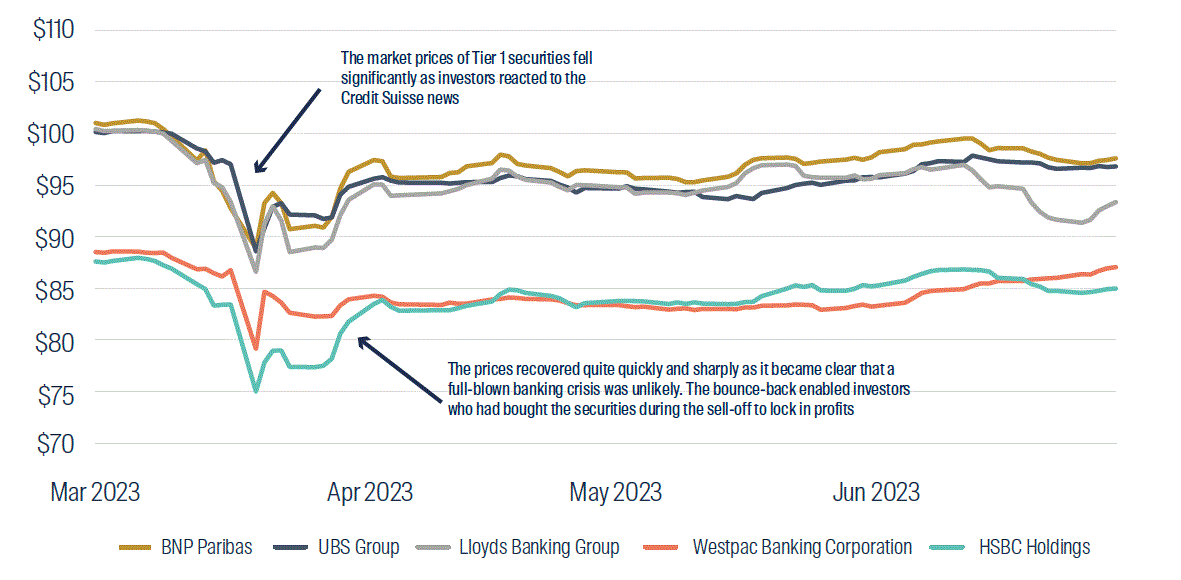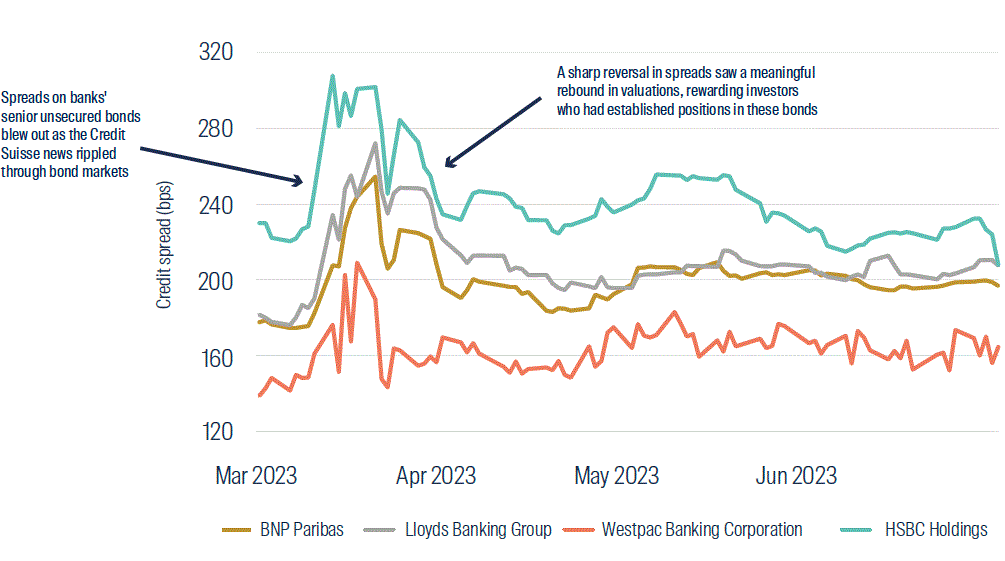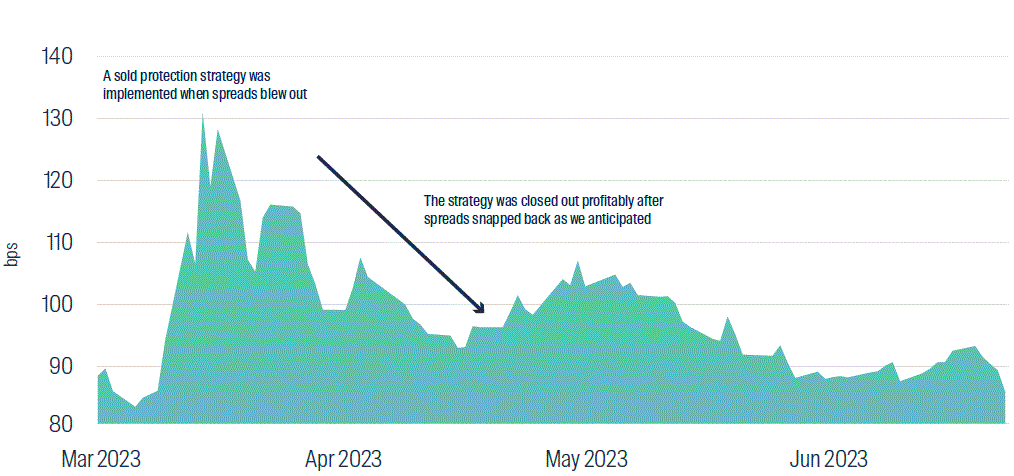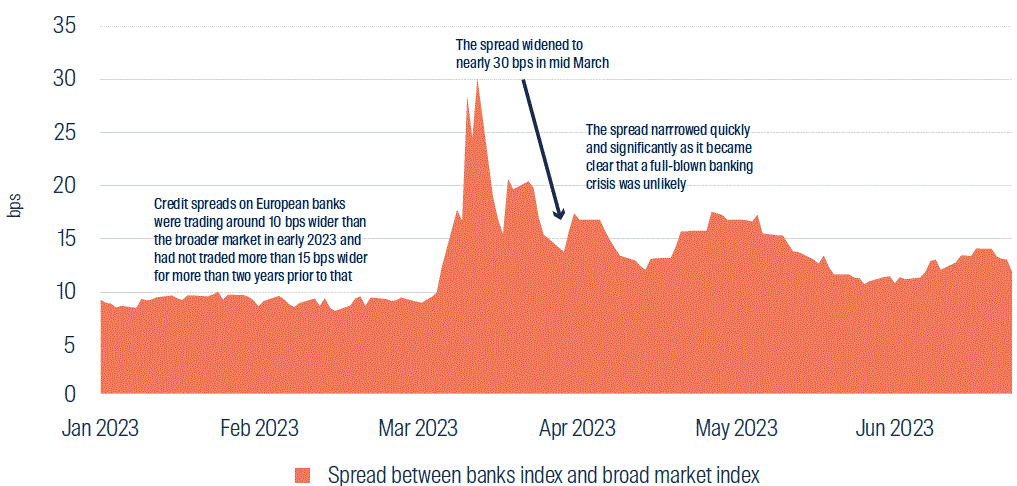In a recent note, we discussed some of the lessons that debt investors can learn from the demise of 170 year old investment bank Credit Suisse.
In this follow-up paper, we highlight some of the alpha opportunities that arose as the fallout from the Credit Suisse developments rippled through bond markets.
Opportunity 1 – Buy Tier 1 Capital notes issued by major global banks
Opportunity 2 – Buy senior unsecured bonds issued by major global banks
Opportunity 3 – Sell protection on the Markit iTraxx Europe Senior Financial Index
An ability to assess evolving risk through fundamental analysis – and a willingness to act swiftly and decisively to amend portfolio positioning when opportunities arise – can enable active managers to exploit market dislocations.
We were able to capitalise on these opportunities in Global Credit portfolios, for the benefit of our investors.
1. Buy Tier 1 Capital notes issued by major global banks
Around the weekend of 18/19 March 2023, when the Swiss National Bank and Swiss Government engineered UBS’s acquisition of Credit Suisse and forced the full write-down of 15.8 billion Swiss francs worth (approx. AUD28 billion) of Credit Suisse Tier 1 securities, prices of Tier 1 Capital notes issued by other major banks fell significantly.
Figure 1: Market prices of major banks’ Tier 1 securities

Source: Bloomberg. Securities shown: BNP Paribas (ISIN FR001400F2H9); UBS Group (ISIN USH4209UAT37); Lloyds Banking Group (ISIN XS2575900977); Westpac Banking Corporation (ISIN US96122UAA25); and HSBC Holdings (ISIN US404280CP20). Data shown from 1 March 2023 to 30 June 2023.
The issues that resulted in the failure of Credit Suisse were idiosyncratic in nature, including the regulator-driven write-down of Tier 1 securities. Importantly, however, the terms of Tier 1 Capital notes issued by other global banks remained unchanged. The market reaction and the sell-off experienced in all banking names globally therefore appeared unwarranted, in our view, essentially reflecting a knee-jerk, panic response among investors.
Whatever the cause, the opportunity created in global Tier 1 Capital note markets was material. The opportunity was also tradeable for experienced investors who were comfortable with the underlying financial strength of each individual bank and who fully understood the regulatory environment in each jurisdiction and the unique features of each individual instrument.
2. Buy senior unsecured bonds issued by major global banks
Similarly, credit spreads on senior unsecured bonds issued by other global banks widened as pressure on Credit Suisse mounted. Senior unsecured bonds ultimately have less risk of being bailed in, and offered a lower risk alpha opportunity.
Figure 2: Credit spreads of major banks’ senior unsecured bonds

Source: Bloomberg. Securities shown: BNP Paribas (ISIN FR001400AKP6); Lloyds Banking Group (ISIN US539439AX74); Westpac Banking Corporation (ISIN XS2575952937); and HSBC Holdings (ISIN US404280DH94). Data shown from 1 March 2023 to 30 June 2023.
These opportunities were also flagged by our proprietary relative value system, which clearly highlighted the pricing disconnect between bank debt and other comparable securities of similar rating and tenor.
Indeed, spreads on Credit Suisse’s senior unsecured bonds understandably widened significantly into the weekend of 18/19 March. This offered an opportunity following the merger announcement to benefit from spread tightening towards the UBS senior unsecured bond levels, which were materially lower.
Again, these substantial market moves provided opportunities for active managers that were able to assess the fundamental difference between global banks and banking regimes.
3. Sell protection on the Markit iTraxx Europe Senior Financial Index
The senior unsecured bond trade was also available synthetically, using the Markit iTraxx Europe Senior Financial Index. This index tracks movements in credit default swaps on 30 equally weighted investment grade European banks.
Similarly, a sold protection strategy opportunity presented itself after credit spreads had blown out around the weekend of 18/19 March 2023.
Figure 3: Market movements in the Markit iTraxx Europe Senior Financial Index

Source: Bloomberg. Data shown for the Markit iTraxx Europe Senior Financial Index (SNRFIN CDSI GEN 5Y Corp) from 1 March 2023 to 30 June 2023
Selling protection on a CDS index[1] effectively results in a bought credit risk position, similar to that of buying an index of senior unsecured bonds issued by the 30 constituent banks. Sellers of protection on the CDS index would therefore profit from any tightening in credit spreads.
Given we believed the sell-off was overdone and that spreads were unlikely to widen any further, we felt comfortable selling the protection. With spreads subsequently snapping back as we anticipated we closed out the position, locking in a mark-to-market gain – the tightening of credit spreads pushed prices higher. The sharp widening in spreads in mid-March and the subsequent snap back is highlighted in Figure 3 above.
The sold protection strategy was available both as an outright trade, and also versus the broader European credit market. Figure 4 below shows the spread differential between the Markit iTraxx Europe Senior Financial Index (the 30 banks) and the Markit iTraxx Europe Index, which tracks movements in credit default swaps on 125 equally weighted investment grade European Corporates across all industry sectors. Again, the opportunity to profit from a reversal in the blow-out in spreads is clear to see in the chart.
Figure 4: Market movements in the Markit iTraxx Europe Senior Financial Index relative to the Markit iTraxx Europe Index

Source: Bloomberg. Data shown for the spread differential between the Markit iTraxx Europe Senior Financial Index (SNRFIN CDSI GEN 5Y Corp) and the Markit iTraxx Europe Index (ITRX EUR CDSI GEN 5Y Corp) from 1 January 2023 to 30 June 2023
Active portfolio management to take advantage of market dislocations around the time of the demise of Credit Suisse generated meaningful value for our Global Credit portfolios.
The alpha derived contributed to the funds’ outperformance relative to their respective benchmarks in the FY23 year as a whole, and helped extend our favourable, long-term performance track record in this asset class.
First Sentier Investors’ Global Credit team are fundamental investors, which means we analyse every bond we invest in. A ‘four eyes’ approach requires each credit assessment to be reviewed by a senior member of the team, to reduce the likelihood of anything being missed and endeavour to ensure the outcome is fair and balanced.
Dedicated credit analysts work independently from the portfolio management team, alerting portfolio managers to evolving risk/reward trade-offs in individual names. This ongoing monitoring helps us take advantage of market dislocations as and when they arise.
The separation between analysts and portfolio managers also helps ensure that risk taking in portfolios remains at an appropriate level and limits the potential for behavioural biases to affect portfolio positioning.
1 Credit Default Swap Index is an over-the-counter derivative contract to provide protection against a credit event.
Disclaimer
This material has been prepared and issued by First Sentier Investors (Australia) IM Ltd (ABN 89 114 194 311, AFSL 289017) (FSI AIM), which forms part of First Sentier Investors, a global asset management business. First Sentier Investors is ultimately owned by Mitsubishi UFJ Financial Group, Inc (MUFG), a global financial group. A copy of the Financial Services Guide for FSI AIM is available from First Sentier Investors on its website.
This material is directed at persons who are ‘wholesale clients’ (as defined under the Corporations Act 2001 (Cth) (Corporations Act)) and has not been prepared for and is not intended for persons who are ‘retail clients’ (as defined under the Corporations Act). This material contains general information only. It is not intended to provide you with financial product advice and does not take into account your objectives, financial situation or needs. Before making an investment decision you should consider, with a financial advisor, whether this information is appropriate in light of your investment needs, objectives and financial situation.
Any opinions expressed in this material are the opinions of the individual author at the time of publication only and are subject to change without notice. Such opinions: (i) are not a recommendation to hold, purchase or sell a particular financial product; (ii) may not include all of the information needed to make an investment decision in relation to such a financial product; and (iii) may substantially differ from other individual authors within First Sentier Investors.
We have taken reasonable care to ensure that this material is accurate, current, and complete and fit for its intended purpose and audience as at the date of publication. No part of this material may be reproduced or transmitted in any form or by any means without the prior written consent of FSI AIM.
Any performance information has been calculated using exit prices after taking into account all ongoing fees and assuming reinvestment of distributions. No allowance has been made for taxation. Past performance is not indicative of future performance.
Copyright © First Sentier Investors, 2023
All rights reserved.
Get the right experience for you
Your location :  Australia
Australia
Australia & NZ
-
 Australia
Australia -
 New Zealand
New Zealand
Asia
-
 Hong Kong (English)
Hong Kong (English) -
 Hong Kong (Chinese)
Hong Kong (Chinese) -
 Singapore
Singapore -
 Japan
Japan



























 United Kingdom
United Kingdom 